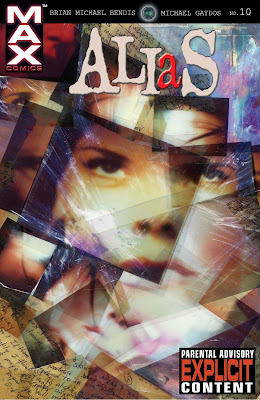 The layout of this page is a deviation from standard comics
because although it is a “strict grid pattern” (Lefèvre 161) at first glance,
once it is read it becomes what might be best described as cyclical, for the
interaction between panels becomes more complex and dependent on earlier panels
for furthering the plot. Additionally, the reader is beginning in a standard
left to right reading, but the comic’s layout demands that the reader rotate
the book physically in a way that does not often occur in standard comics. In
my own experience reading this comic I first felt that it would have greatly
benefitted from guided view reading because it would enable the reader to
experience the same misunderstanding as Finn does when he thinks that the
material we known is separating rooms is not just a mirror. But the more I
thought about it, I came to a different conclusion.
The layout of this page is a deviation from standard comics
because although it is a “strict grid pattern” (Lefèvre 161) at first glance,
once it is read it becomes what might be best described as cyclical, for the
interaction between panels becomes more complex and dependent on earlier panels
for furthering the plot. Additionally, the reader is beginning in a standard
left to right reading, but the comic’s layout demands that the reader rotate
the book physically in a way that does not often occur in standard comics. In
my own experience reading this comic I first felt that it would have greatly
benefitted from guided view reading because it would enable the reader to
experience the same misunderstanding as Finn does when he thinks that the
material we known is separating rooms is not just a mirror. But the more I
thought about it, I came to a different conclusion.
The comic’s layout and plot
play with time and space in a very interesting way and not seeing the bigger
picture immediately would make this more intriguing but it would also make the
relationships between panels in the larger space lessened. In a way we can read
the comic (as indicated by the red arrows) in a normal one panel at a time, but
we can also read it as pairs of panels (top and bottom) since the divider
itself is referenced in character’s speech and visually draws the eye due to
it’s colour.
 Speaking of colour, Scott McLeod writes in Understanding Comics “the differences
between black-and-white and colour comics are vast and profound, affecting
every level of the reading experience” (192). This lead me to think about what
the comic would be like without the current colouring. The reader would
probably have more difficulty orientating his or her eyes on the page, as the bright
red arrows would not draw the eye any longer. Also, you might not see the pairs
of panels right away as with the colour present you immediately pick up that
Finn and Jake are present but also quickly make note of their orientation in
the top panels. I would assume that this would be hindered somewhat with just
black and white. The overall “spooky” tone of the comic would be lost without
the blue colouring which features in a large percentage of the panels of this
comic. What might occur instead would be that more drawing would have to be
included in each panel to reinforce the same mood that is achieved easily with
colour.
Speaking of colour, Scott McLeod writes in Understanding Comics “the differences
between black-and-white and colour comics are vast and profound, affecting
every level of the reading experience” (192). This lead me to think about what
the comic would be like without the current colouring. The reader would
probably have more difficulty orientating his or her eyes on the page, as the bright
red arrows would not draw the eye any longer. Also, you might not see the pairs
of panels right away as with the colour present you immediately pick up that
Finn and Jake are present but also quickly make note of their orientation in
the top panels. I would assume that this would be hindered somewhat with just
black and white. The overall “spooky” tone of the comic would be lost without
the blue colouring which features in a large percentage of the panels of this
comic. What might occur instead would be that more drawing would have to be
included in each panel to reinforce the same mood that is achieved easily with
colour.
Works Cited
Lefèvre, Pascal. “The Construction of Space in Comics.” A
Comics Studies Reader. Eds. Jeet
Heer and Kent Worcester. Jackson, MS:
University Press of Mississippi, 2009.
157-62.
- McCloud, Scott. Understanding Comics: [the Invisible Art]. New York: HarperPerennial, 1994. Print.



















